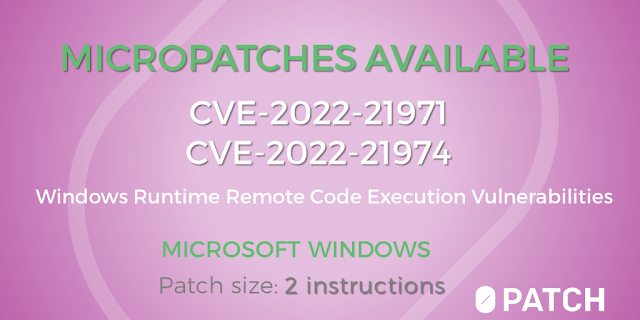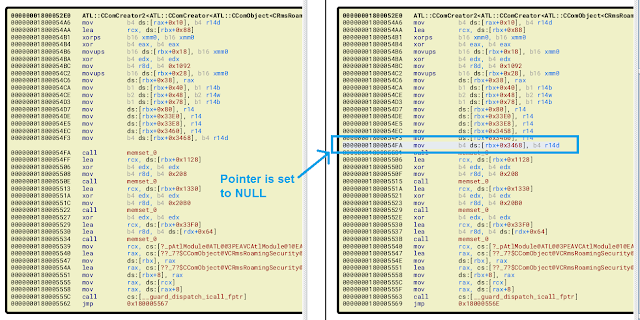by Mitja Kolsek, the 0patch Team
Twelve days ago, security researcher Axel Souchet published detailed analyses with associated proofs-of-concept for two remotely exploitable vulnerabilities in Windows that were fixed by Microsoft with February Windows Updates. Both vulnerabilities are similar and are caused by an uninitialized pointer that a malicious RTF file can get freed while having an illegal value.
Exploitability of such issues depends on whether the attacker can get the uninitialized value to point to a chosen address and thus control the resulting memory corruption. We don't know if this is possible but following the worst-case assumption principle (and historical track record showing that to be generally possible with sufficient motivation), unexplored memory corruption issues are assumed to allow for a remote code execution.
The two vulnerabilities are:
While Axel found these vulnerabilities, he was not the only one; both issues were reported to Microsoft by Zesen Ye and Zhiniang Peng with Sangfor, and CVE-2022-21971 also by Jinquan with DBAPPSecurity Lieying Lab. There was some initial uncertainty on whether these CVE IDs really matched Axel's findings, but Zhiniang has confirmed the match.
It was trivial to reproduce both issues by simply enabling Page Heap for WordPad.exe and opening Axel's RTF documents with WordPad. While WordPad requires the user to unblock content in a security warning, opening the same document in Microsoft Word produces no warnings. We preferred using WordPad for our analysis, however, as it is present on Windows by default.
Our analysis of Microsoft's fixes for these issues revealed that, unsurprisingly, they just added pointer initialization to constructor code. The image below shows a diff between vulnerable (left) and fixed constructor (right) in RMSRoamingSecurity.dll., and something similar was done in prauthproviders.dll as well.
Our micropatches are logically equivalent to Microsoft's. They were written for the following Windows versions that don't receive official patches from Microsoft:
- Windows 10 v1803 updated to May 2021
- Windows 10 v1809 updated to May 2021
- Windows 10 v2004 updated to December 2021
Note that Windows 7 and Server 2008 R2 are not affected as the vulnerable functionalities do not exist there.
Here is a video showing how 0patch blocks exploitation of these vulnerabilities:
These
micropatches have already been distributed to all
online 0patch Agents with a PRO
or Enterprise license. To obtain them and have them applied on your
computers along with our other micropatches,
create an account in 0patch Central, install 0patch Agent and register it to your account with a PRO or Enterprise subscription. Note that no computer restart is needed for installing the agent or applying/un-applying any 0patch micropatch.
We'd like to thank Axel Souchet for publishing their analyses and providing proofs-of-concept that allowed us to reproduce these vulnerabilities and create micropatches for them. We also encourage security researchers to privately share their analyses with us for micropatching.


No comments:
Post a Comment